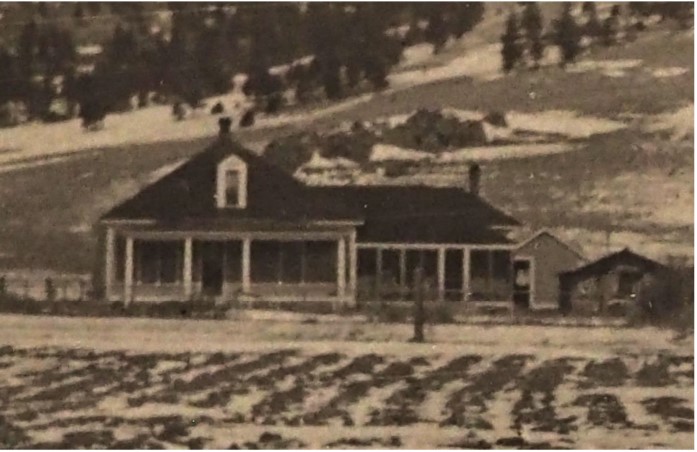Three Historic Properties Nominated to National Register

Three historic properties are under consideration for listing in the National Register of Historic Places.
The Billings Communal Mausoleum, the McMaster Ranch near Broadwater, and Shaw’s Best Factory in Helena (whose products included pancake flour, and baking powder) were presented to the Montana State Historic Preservation Review Board May 14. The board approved forwarding all three nominations to the Keeper of the National Register in Washington D.C. After receipt, the Keeper has 30 days to review the nominations.
“We’re thrilled with the caliber of these nominations, said John Boughton, National Register Coordinator for the State Historic Preservation Office. “Each nomination represents an important aspect of Montana’s history, and recognizes our state’s significant places.”
Mausoleum
Also known as the Mountview or Landmarks mausoleum, the Billings Communal Mausoleum sits atop a high point on the western edge of Mountview Cemetery. It is one of three known community mausoleums built in Montana during the early 20th century.
The City of Billings commissioned prominent Montana architect John Gustave Link to design the 330-crypt mausoleum, and construction of the $100,000 structure began under the direction of Frank Hebb in late 1920. It was the state’s first community mausoleum when it began operation in 1922, and the city dedicated it in 1924.
“Designed around the concept of enduring and indestructible beauty, the entire structure was constructed of reinforced concrete with a marble-clad interior and bronze and copper detailing,” wrote Anna Kooistra-Manning, who contracted with the Western Heritage Center to prepare the nomination form. “The walls are finished with simple, geometric detailing and brush-hammered texture painted white.”
The Billings Mausoleum represents a change in traditional burial practices away from churchyards and private family graveyards to burials in landscaped public cemeteries. This change occurred in part due to public health initiatives in the late 1800s that brought attention to the issues of sanitation and hygiene to prevent the spread of contagious diseases.
McMaster Ranch
The famed McMaster Ranch sits at the south end of the Spokane Bench between Helena and Winston.
The nomination is based on the historic buildings and structures at the ranch headquarters; the irrigation system that made the ranch operable; transportation elements influencing the property’s history; and lands acquired using several Homestead Act permutations, which is a major attribute of its historic development.
“By 1956, the ranch headquarters was fully established; barns, ditches, garages, sheds, and corrals that are still standing were in place,” wrote historian Paul Putz in the nomination form. “… The overall high level of historical integrity remains a prime element of the significance of the McMaster Ranch.”
The ranch has been in the McMaster Family since 1893.
“Family lore holds that William (McMaster) lived in a tent while constructing the ranch buildings. This is plausible,” Putz wrote. “He had a home in Helena and a business there, and the process of erecting a house, blacksmith shop, a barn, and hand-digging a (100-foot-deep) well was probably undertaken in the course of interruptions and diversions.”
The McMaster family’s original 160 acres were on the road between Helena and Bozeman, but also at the west side of the ferry route across the Missouri River between what was then Diamond City in the Big Belt Mountains and the west side of the river. William died in 1902, but his wife Lizzie and son James’ families expanded the ranch by 1,500-plus acres.
Lizzie planted an apple orchard in the late teens or early 1920s, which remains today, as do the house, outbuildings, and former schoolhouse. Dolly McMaster and her brother James "Bud" McMaster managed the ranch through the 2000s. They created a conservation easement, then transferred ownership to the Bureau of Land Management in 2005, with the understanding and funding to main the ranch headquarters and lands "well into the future."
Shaw’s Best Factory
Shaw’s Best Factory in Helena, designed by Helena architects Carl Neuhausen and Frank Williams in 1890, is a two-story American Foursquare building of stone quarried from Mount Helena.
Originally a carriage house and animal shelter, in 1893 George W. and Eliza Shaw converted the building behind their family home to a home industry, manufacturing baking powder and pancake flour. Shaw’s Best products included Montana Peerless Baking Powder, Shaw's Best Pancake Flour, and Shaw's Best Wheat Cream-lets. The company marketed to and supplied stores statewide and advertised their commitment to using only Montana-grown wheat. Three generations of the Shaw family founded and operated the company through 1918.
Joseph and Patricia Sidor bought the property in 1956, and the family still owns it. In 1995, the Helena and Lewis and Clark County Historic Preservation Commission awarded the Sidor family a Historic Preservation Award for their care and attention toward preserving the integrity of the Shaw's Best Factory.
For more information, contact Eve Byron at the Montana Historical Society at 406/444-6843 or eve.byron@mt.gov